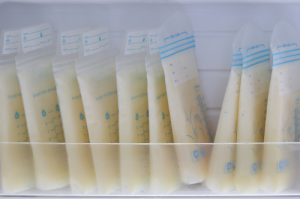
Recently an older (but amazing) study by Cacho et al (2017) about cultivating maternal microbiota in samples of donor milk for sick and preterm infants started doing the rounds on social media. I’m not sure why it suddenly went viral, but it’s something that comes up not infrequently in my work with very sick children.
It is strongly recommended that sick and preterm infants receive human milk – preferably their own mother, but if this is not available, to use donor milk. This is because of the increased risk of necrotising enterocolitis and other harmful illnesses for these vulnerable infants. Human milk is easier to tolerate, poses less risk of exposure to foreign proteins and allergens, and is more bioavailable.
One of my (many) frustrations with the patchiness of breastfeeding support in paediatrics is that there isn’t a well-established protocol for using donor human milk as standard for very sick or vulnerable older babies and children. I support hundreds of families whose children are immunocompromised, or have serious illnesses and who would arguably benefit from human milk. Many of the children I support struggle with malabsorption, poor weight gain, poor food tolerance, multiple infections, nausea and gastrointestinal upset.
Anecdotally, these children do much better with human milk than with the solid food or other fluids they often struggle with, which is why I am working so hard to support these families to be able to carry on breastfeeding through major illness if they want to. But for the parents who have already stopped breastfeeding, or cannot continue to breastfeed, I wish donor milk was a more widespread and acceptable intervention both from a dietary, but also immunological point of view.
Apart from the logistical and practical issues of donor milk, the only significant potential problem is the absence of bacteria. It is well-known that bacteria counts in human milk are abundant – with counts of 1 × 105 to 1 × 107 reported in this study which provides an important source of immunological cross talk and probiotics for the developing child. Donor milk is incredible, but it lacks bacteria because of the (essential) pasteurisation process.
In the study exploring the feasibility of culturing maternal bacteria in donor milk the researchers mixed small amounts of the mother’s milk in with the donor milk at different concentrations and measured the bacterial counts at specific time points.
The short version is that the bacterial counts of the altered donor milk after 4, and 8 hours of incubation at 37°C reached comparable diversity with the mother’s milk, suggesting that donor milk could be ‘engineered’ to personalise it for infants in order to positively affect their microbiome.
The implications of this are huge for sick children. Many of the parents I support are caring for older children, and have not used a pump for a long time. It is an entirely different situation to have your one-year-old admitted to PICU and ventilated, after months of relative breastfeeding ease. Some parents are able to express milk, but many not, or are only able to produce small volumes – either due to the extraordinary stress they are under, low supply, or high caloric need of their sick child. Sometimes the child was only minimally nursing because they are much older, and therefore the amount of milk they can express is negligible, yet their fluid requirements are high. This is a low-tech intervention that could positively benefit the most vulnerable children.
Closely related to this issue is one of my related interests in the retrograde inoculation theory (backwash) where infant saliva causes microbial cross talk with the mammary microbiome, effectively causing the milk to be altered in response to the infant’s environmental exposure. To my knowledge, this theory was first proposed following evidence discovered by the CHILD study team (Moossavi et al, 2019) and expanded by Beghetti et al, 2019. Essentially, during suckling, the child’s saliva enters the mammary tissue and via the entero-mammary pathway, affects the microbiota of the milk produced. While there are other mechanisms that contribute to the bacterial ‘rainbow’ in milk, this one is of particular interest to the parents I support whose children are on chemotherapy.
With the population of very sick children I am interested in and working to support both practically and in my research, I am interested in how the mammary microbiome responds when children are very sick, or have altered microbiomes due to multiple antibiotic exposure, as well as the toxic drugs they are exposed to.
How does the mammary microbiome deal with this? I’d absolutely love to research this and dig more into how we can use low tech lacto-engineering to enhance immune response with extremely vulnerable infants and children… For now, my curiosity will have to be patient!
One thing is for sure though – we are only beginning to scratch the surface of what milk is capable of, the role it could play in immunity, and how it responds and adapts to different conditions. The possibilities for milk as medicine are exciting.
If this topic leaves you wanting more, you can check out my book Breastfeeding the Brave, as well as the 1-day course by the same name, and feel free to swing by my designated website www.breastfeedingthebrave.com where I’ve collated all my work on this topic, including my published articles.

Leave A Comment
You must be logged in to post a comment.